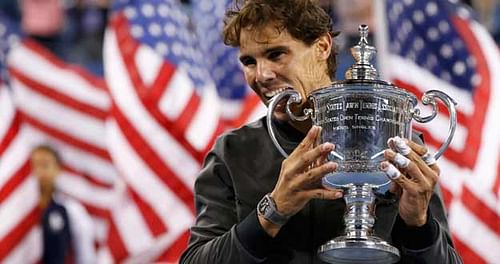
Rafael Nadal and the GOAT conundrum

GOAT – acronym for Greatest of All Time, and subject of one of the most intense discussions taking place for quite some years now in the tennis circuit.
While I am unaware of how the perception of the subject moved in the pre-Open era, or the time-span involving the likes of Borg, Lendl, McEnroe and Connors or more recently, Sampras and Agassi, it’s the recent spate of discussions involving Roger Federer and Rafael Nadal on this topic that I find quite intriguing as an observer of the sport.
The continuing tug-of-war of supremacy between Federer and Nadal
Between them, Federer and Rafa have won 144 titles including 31 Majors and 49 Masters, with the definite possibility of adding more to their individual – and combined – kitty. For Federer though, this possibility seems much nearer than the Mallorcan, who is out of the US Open nursing a injury to his wrist. However, once Rafa makes his comeback the tussle for the GOAT spot will continue as if it were never interrupted in the first place.
Their domination has been absolute, even if Federer is no longer the same all-conquering force that he once used to be. There are a few factors that go in favour of one player, as there are aspects that detract from the other. But the facet that gets tossed about most often is about the player holding the edge – slight as it may be – over the other.
Deciphering the GOAT paradigm
For an impartial follower there would always be two places allotted as far as the GOAT debates are concerned, with both the Swiss and the Spaniard making the cut. Each has enhanced the competitiveness of the sport so tremendously that one feels wary about thinking about the long-term future of the sport in their absence.
But even in the realms of impartiality, there are a few observations that cannot be ignored and which make the whole GOAT debate a bit more controversial.
Rafa’s dominance at the French Open has been an important factor alongside his head-to-head superiority in arguing that he is more deserving of the GOAT title than his rival from Basel. Federer has not only failed to exert a similar surge of success on any one surface, but has also come up short in most matches when these two guys have played each other.
The consistency factor
The consistency factor remains a crucial issue though, and one that often gets conveniently shrouded.
The Mallorcan’s indefatigable presence at the French Open – and at the events marking the run-up to it – is definitely the trump card that he holds in the statistical margin of his career as far as longevity is concerned. However, that statistic falls to a certain extent in terms of consistency when his appearances and results at other events, even the Majors, are calculated.
In contrast, Federer’s longevity is synonymous with consistency, despite the aberration of last year.
Can there ever be a definite conclusion to the debate?
The argument isn’t about whether Rafael Nadal merits the badge of honour of being the greatest player, but rather about recent one-sided nature of the GOAT debates.
The numerous pull-outs – especially the 11th hour ones – that the 14-time Major winner has been forced to from numerous events, to the point of not being able to defend his titles, cannot be held up as a blemish on his legacy or attributed to his carelessness or frivolousness. The fact that he has achieved everything in spite of these recurring adversities is a stamp of his persistence, deserving of all the plaudits that have come his way.
However, the fact remains that the Spaniard’s game play is such that his body is forced to demand intermittent breaks to recuperate. And his inconsistency off clay throws a spanner in the argument that the Spaniard holds the edge over the Swiss.
To my mind, Federer and Nadal merit to be on par with each other; neither lower nor higher than the other.